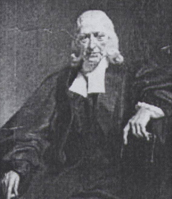

The Methodist movement began in the eighteenth century with John Wesley and his friends. He began to visit Cornwall and small meetings were held in peoples houses while large groups met in the open air. Gradually chapels were built and the Wesleyan Methodists were formed.
John Wesley visited to Cornwall thirty-two times between 1743 to 1787. An
exhausting trip of about six days from London by horseback, frequent stopovers
were required. One of these was at Trewint where the owner of a cottage built
an addition to their cottage to provide Wesley and his preachers comfort for
rest and study. Trewint, near Altarnun,
became the centre of a flourishing Methodist Society, but eventually larger
chapels were opened, the rooms in Isbell Cottage fell into disuse. In 1950 the
Isbell house and the two adjoining rooms were restored and opened to the public
as Wesley Cottage. Trewint
Wesley Cottage, Cornwall In his 1781 visit to Gwennap Pit, Wesley estimated
that he had preached to "20,000 people and, the evening being calm, all
could hear."
Wesley's main preaching was directed at the poor and uneducated miners and fishermen
and their families in Cornwall. The
Established Church, the Church of England (Anglican) was the church of the more
prosperous. John Wesley preached eighteen times to mainly miners, and farmers
and fishermen, too, at the Gwennap
Pit, a large circular depression, probably a partial collapse of an underground
mine, about two and a half miles from Redruth. The congregation sat or stood
on the inclined sides of this pit which was described by Wesley in his journal
as being about fifty feet deep and two hundred by three hundred feet across
the top.
In 1806, as a memorial to John Wesley, it was reorganised to it's current thirteen regular concentric terraces built by backfilling earth behind granite "walls" built to seating height. An estimated two thousand people can be seated for a service.
September 6th, 1762 was Wesley's first visit to Gwennap Pit. His last was in
1789.
He preached at many outdoor venues because, although he was an ordained Anglican
priest,Wesley was often denied the right to preach in the local Church of England
by the local vicar. He also set up health facilities and illiteracy programmes
for men and women so that they could better themselves economically.
William O'Bryan (alias Bryant) of Luxulyan began a breakaway movement in around 1815 called the Bible Christians and in parts of Cornwall this branch of Methodism was more popular than the Wesleyans. Many towns and villages had both a Wesleyan and a Bible Christian Chapel.
The Primitive Methodists also began in the early part of the nineteenth century and in places was as popular as the Wesleyans or the Bible Christians.
There were many other groups of Methodists such as the Wesleyan Reform Union, the Methodist New Connexion and Lady Huntingdons Connexion but these were never such large movements as the three main ones.
The names of the Methodist Circuits which covered Cornwall in 1851 are as follows on a list in Genuki:
T o The Wesleyan Methodist Circuits: St Agnes; St Austell; Bodmin; Callington; Camborne; Camelford; St Columb; Gwennap; Falmouth; Hayle; Helston; St Ives; St Just; St Keverne; Kilkhampton; Launceston; Liskeard; Marazion; St Mawes; Mevagissey; Newlyn East; North Hill; Penzance; Perranwell; Redruth; Isles of Scilly; Truro; Tuckingmill.
o The Bible Christian Methodist Circuits: St Austell; St Columb; St Ervan; Falmouth & Penryn; Hayle; Helston; Hick's Mill; St Just; Kilkhampton; Launceston; Liskeard; Looe; Luxulyan; Mevagissey; Michaelstow; St Neot ; Padstow; Penzance; Porthleven; Redruth & Camborne; Isles of Scilly; Truro; Week St.Mary.
o The Primitive Methodist Circuits: St Austell; Camborne; St Day; Falmouth; St Ives; Liskeard; Penzance; Redruth.
o The Wesleyan Methodist Association Circuits: St Agnes; St Austell; Bodmin; Camborne; Camelford; Helston; Launceston; Penzance; Polperro; Redruth.
o The Methodist New Connexion Circuits: St Ives; Penzance; Truro.
o The Wesleyan Reform Union Methodist Circuits: St Just; Liskeard.
Gradually all the groups began to join with each other, some forming the United Methodists in the middle of the nineteenth century, until in 1932 the Methodist Church was formed to which most the the sects subscribed although there are still some independent Chapels.
The Cornwall Methodist District covers almost all of the County of Cornwall and includes the Isles of Scilly. There are two Methodist churches in the island Circuit with a further 255 churches divided between the 19 mainland Circuits.
Cornwall Methodist Legacy appears to specialise in genealogical information